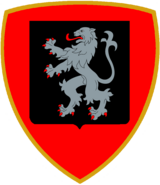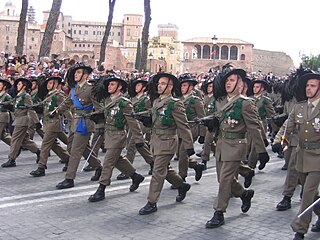
The Bersaglieri, singular Bersagliere, are a troop of marksmen in the Italian Army's infantry corps. They were originally created by General Alessandro Ferrero La Marmora on 18 June 1836 to serve in the Royal Sardinian Army, which later became the Royal Italian Army. They can be recognized by their distinctive wide-brimmed hats decorated with black western capercaillie feathers, which is worn with the dress uniform. The feathers are also applied to their combat helmets.

The 3rd Alpini Regiment is a regiment of the Italian Army's mountain infantry speciality, the Alpini, which distinguished itself in combat during World War I and World War II. The regiment is based in Pinerolo and assigned to the Alpine Brigade "Taurinense".
On March 1, 1984 the Italian Institute for Disarmament, Development and Peace (Istituto di ricerche per il disarmo, lo sviluppo e la pace in Rome published the entire Italian Army order of battle down to company level – this was justified by the radical party as one of its core demands was total disarmament of Europe, even though the data which was published was top secret. The Radical Party dissolved in 1989 and the IRDISP followed suit in 1990. But Radio Radicale has survived, and the OrBat can still be found today on the homepage of the radio.

The Cavalry Brigade "Pozzuolo del Friuli" is a brigade of the Italian Army, based in the Friuli Venezia Giulia and Veneto regions. The Brigade consists of a command unit, a cavalry regiment, an amphibious infantry regiment, an artillery regiment, an engineer regiment and a logistic regiment.

The Mechanized Brigade "Granatieri di Sardegna" is a mechanized infantry brigade of the Italian Army, based in Rome and central Italy. The brigade fields one of the oldest regiments of the Army and is one of the guard regiments of the President of Italy. The name of the unit dates back to the Kingdom of Sardinia and not the eponymous Mediterranean island of Sardinia. The brigade is part of the Division "Acqui".

After World War II the Italian Army had two units named "Centauro": from 1952 to 1986 the Armored Division "Centauro" and from 1986 to 2002 the Armored Brigade "Centauro". Both units were successor to the World War II era 131st Armored Division "Centauro". The units' name came from the mythological race of half human-half horse creatures named Centaurs.

The Armored Brigade "Vittorio Veneto" was an armored brigade of the Italian Army. Its core units were armored and mechanized cavalry squadrons groups. The brigade's headquarters was in the city of Villa Opicina, with most of its units based in the Province of Trieste. The brigade's name was chosen to remember the decisive Italian World War I victory at the Battle of Vittorio Veneto.

The 132nd Armored Brigade "Ariete" is currently the only active armored brigade of the Italian Army. Its core units are tank and Bersaglieri regiments. The brigade's headquarters is in the city of Pordenone and most of its units are based in the North-East of Italy. The brigade's name comes from the battering ram. The brigade draws much of its historical traditions from the 132nd Armored Division "Ariete", which fought in the Western Desert Campaign of World War II. In 1948 the Ariete was reconstituted as division and remained active until 1986. Today the brigade is part of the Division "Vittorio Veneto".
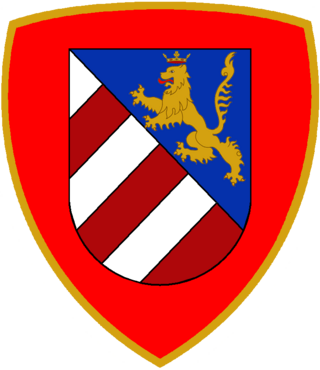
The Mechanized Brigade "Gorizia" was a mechanized brigade of the Italian Army. Its core units were mechanized infantry battalions. The brigade's headquarters was in the city of Gorizia and the brigade's units were based in the region of Friuli Venezia Giulia. The brigade's name was chosen in memory of the World War I Battle of Gorizia. The brigade's sister brigade, the Armored Brigade "Vittorio Veneto", was named to commemorate the World War I Battle of Vittorio Veneto.

The Mechanized Brigade "Mantova" was a mechanized brigade of the Italian Army. Its core units were mechanized infantry battalions. The brigade's headquarters was in the city of Cividale del Friuli and all the brigade's units were based in the region of Friuli Venezia Giulia. In 2003, the "Mantova" was raised again as a division command.

The Mechanized Brigade "Legnano" was a mechanized brigade of the Italian Army. Its core units were mechanized infantry battalions. The brigade's headquarters was in the city of Bergamo in Lombardy. The name of the brigade commemorates the Lombard League victory in the Battle of Legnano in 1176 and its coat of arms depicts the Monument to the Warrior of Legnano in the centre of Legnano.

The Motorized Brigade "Cremona" was an infantry brigade of the Italian Army. The brigade's headquarters was in the city of Turin. The brigade carried on the name and traditions of the 44th Infantry Division "Cremona".

The Mechanized Brigade "Trieste" was a mechanized brigade of the Italian Army. Its core units were mechanized infantry battalions. The brigade's headquarter was in the city of Bologna. Named after the North-Eastern city of Trieste the brigade's coat of arms was modeled after the city's coat of arms.

The Mechanized Division "Folgore" was a mechanized division of the Italian Army. Its core units were three mechanized brigades. The brigades headquarters was in the city of Treviso.
The following is a hierarchical outline for the Italian Army at the end of the Cold War. It is intended to convey the connections and relationships between units and formations.

The Mechanized Brigade "Isonzo" was a short-lived brigade of the Italian Army created during the 1975 army reform and renamed Mechanized Brigade "Mantova" during the 1986 army reform. The name of the brigade was chosen to commemorate the twelve Battles of the Isonzo during World War I.
With the 1975 reforms the Italian Army abolished the regimental level and replaced it with brigades made up of multiple arms. During the reform the army disbanded 48 regimental commands and reduced its force by 87 battalions. A further ten regimental commands were used to raise ten new brigade commands. Ten training centers, which for traditional reasons had carried the names of regiments, were also disbanded. The reduction in units also allowed to mechanize most of the remaining units in Northern Italy and Italy's defense strategy changed from a hold-at-all-costs territorial defense to one of mobile warfare.

The Alpini Battalion "Tirano" is an inactive battalion of the Italian Army's mountain infantry speciality, the Alpini, which distinguished itself in combat during World War I and World War II.
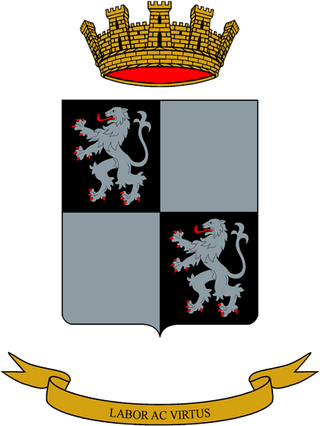
The Logistic Regiment "Aosta" is a military logistics regiment of the Italian Army based in Palermo in Sicily. The regiment was formed on 1 June 2015 and is the logistic unit of the Mechanized Brigade "Aosta". On 20 November 2015 the regiment received the flag of the Logistic Battalion "Aosta" and thus received the name and traditions of the Logistic Battalion "Aosta". The regimental anniversary falls, as for all units of the Transport and Materiel Corps, on 22 May, the anniversary of the Italian Army's first major automobile use to transport reinforcements to counter the Austro-Hungarian Offensive at Asiago in 1916.
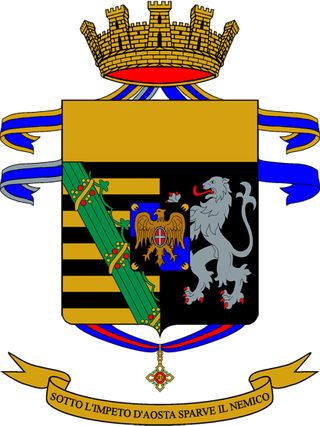
The 5th Infantry Regiment "Aosta" is an active unit of the Italian Army based in Messina in Sicily. The regiment is part of the Italian army's infantry corps and operationally assigned to the Mechanized Brigade "Aosta".
